Analyzing and Addressing Communication Barriers in Business Management
VerifiedAdded on 2023/06/08
|11
|2884
|168
Report
AI Summary
This report examines the critical role of effective communication in business operations, highlighting various barriers that can impede progress. It delves into the impact of perceptual, emotional, language, cultural, and physical barriers on individuals and teams, emphasizing their negative effects on decision-making, employee trust, and overall productivity. The report then explores strategies to mitigate these challenges, including the application of the Johari window model and the Shannon Weaver model to improve communication flows. Furthermore, it stresses the importance of understanding employee needs, conducting routine checks on communication systems, and providing training to enhance communication skills within the organization. Ultimately, the report aims to provide insights into how businesses can foster a more transparent and efficient communication environment, leading to improved goal achievement and organizational success.
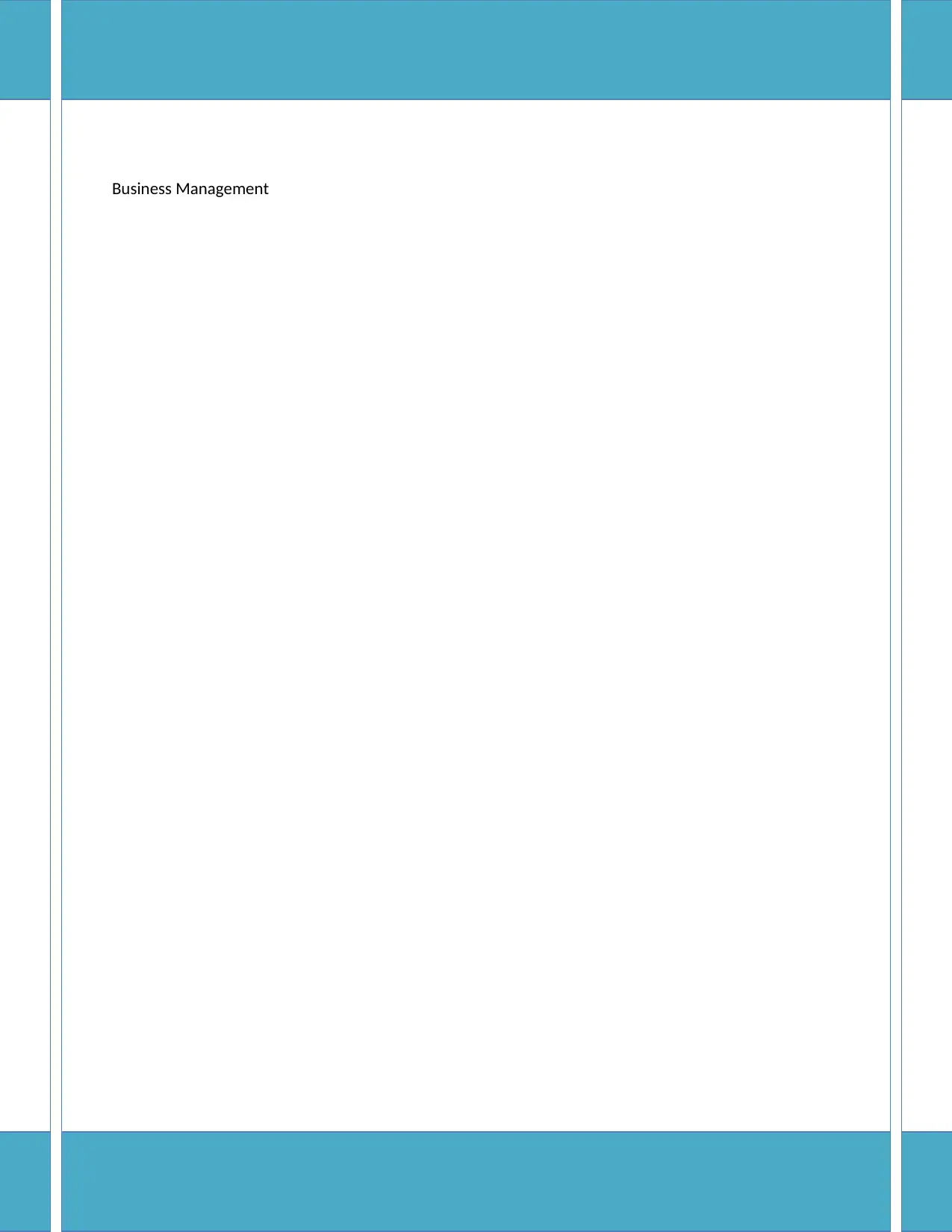
Business Management
Paraphrase This Document
Need a fresh take? Get an instant paraphrase of this document with our AI Paraphraser
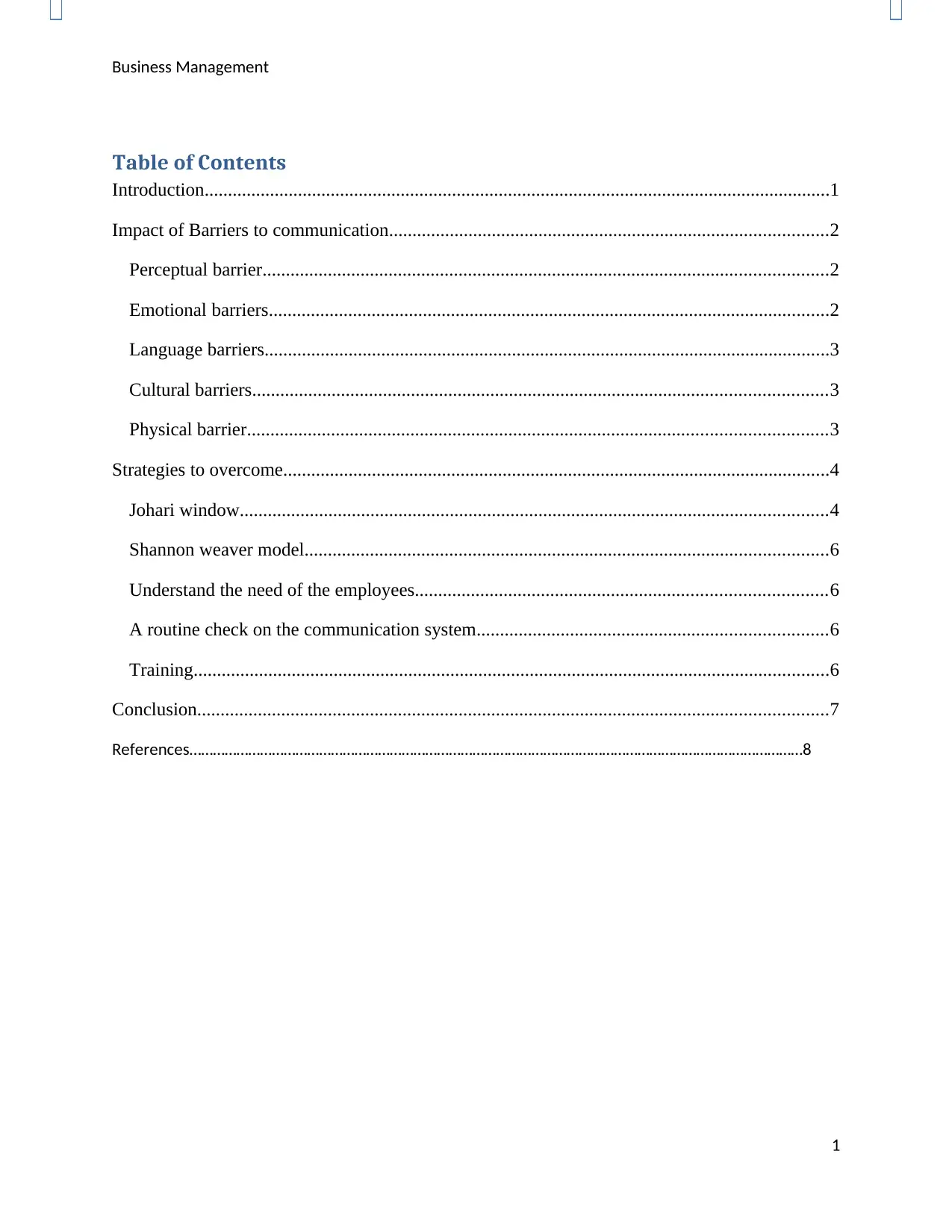
Business Management
Table of Contents
Introduction......................................................................................................................................1
Impact of Barriers to communication..............................................................................................2
Perceptual barrier.........................................................................................................................2
Emotional barriers........................................................................................................................2
Language barriers.........................................................................................................................3
Cultural barriers...........................................................................................................................3
Physical barrier............................................................................................................................3
Strategies to overcome.....................................................................................................................4
Johari window..............................................................................................................................4
Shannon weaver model................................................................................................................6
Understand the need of the employees........................................................................................6
A routine check on the communication system...........................................................................6
Training........................................................................................................................................6
Conclusion.......................................................................................................................................7
References…………………………………………………………………………………………………………………………………………8
1
Table of Contents
Introduction......................................................................................................................................1
Impact of Barriers to communication..............................................................................................2
Perceptual barrier.........................................................................................................................2
Emotional barriers........................................................................................................................2
Language barriers.........................................................................................................................3
Cultural barriers...........................................................................................................................3
Physical barrier............................................................................................................................3
Strategies to overcome.....................................................................................................................4
Johari window..............................................................................................................................4
Shannon weaver model................................................................................................................6
Understand the need of the employees........................................................................................6
A routine check on the communication system...........................................................................6
Training........................................................................................................................................6
Conclusion.......................................................................................................................................7
References…………………………………………………………………………………………………………………………………………8
1
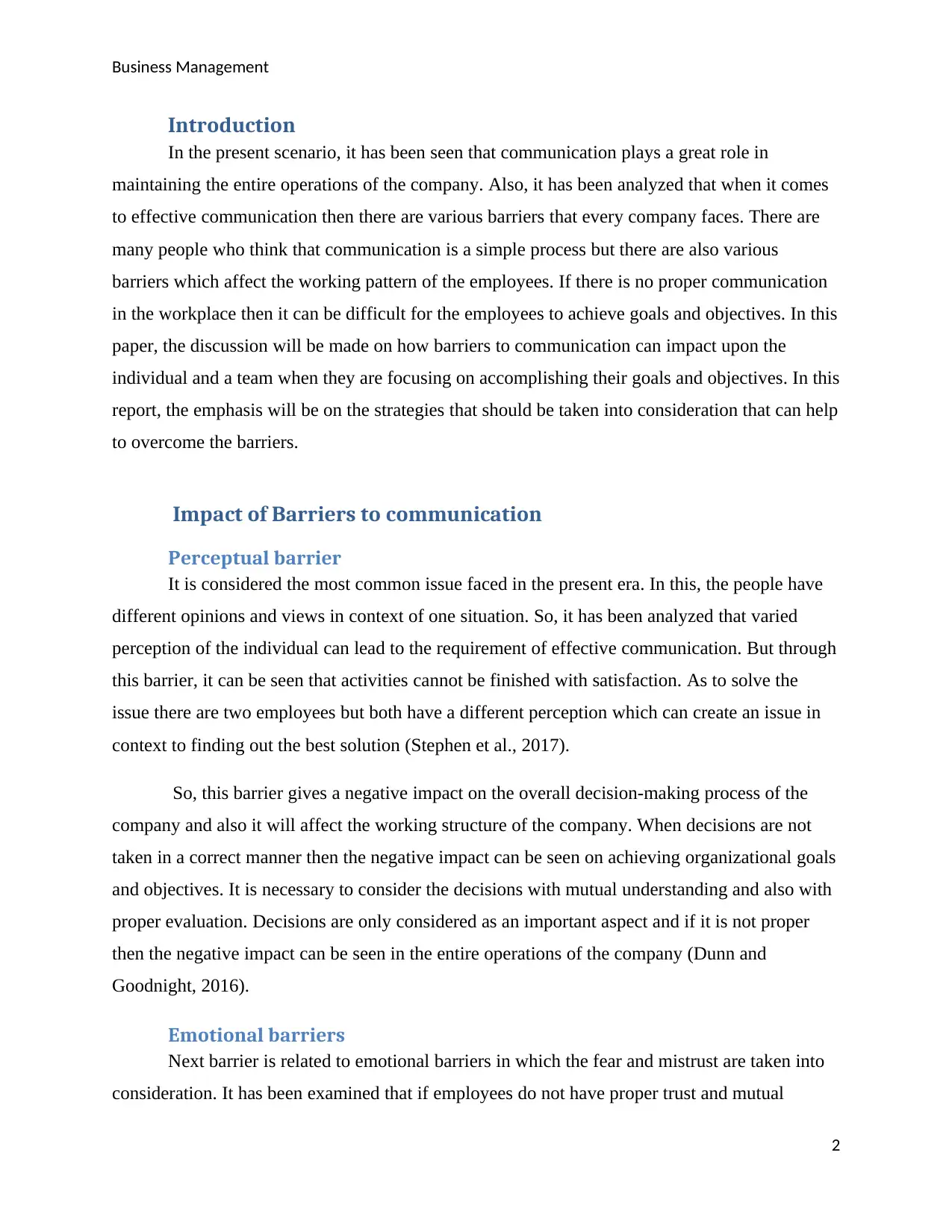
Business Management
Introduction
In the present scenario, it has been seen that communication plays a great role in
maintaining the entire operations of the company. Also, it has been analyzed that when it comes
to effective communication then there are various barriers that every company faces. There are
many people who think that communication is a simple process but there are also various
barriers which affect the working pattern of the employees. If there is no proper communication
in the workplace then it can be difficult for the employees to achieve goals and objectives. In this
paper, the discussion will be made on how barriers to communication can impact upon the
individual and a team when they are focusing on accomplishing their goals and objectives. In this
report, the emphasis will be on the strategies that should be taken into consideration that can help
to overcome the barriers.
Impact of Barriers to communication
Perceptual barrier
It is considered the most common issue faced in the present era. In this, the people have
different opinions and views in context of one situation. So, it has been analyzed that varied
perception of the individual can lead to the requirement of effective communication. But through
this barrier, it can be seen that activities cannot be finished with satisfaction. As to solve the
issue there are two employees but both have a different perception which can create an issue in
context to finding out the best solution (Stephen et al., 2017).
So, this barrier gives a negative impact on the overall decision-making process of the
company and also it will affect the working structure of the company. When decisions are not
taken in a correct manner then the negative impact can be seen on achieving organizational goals
and objectives. It is necessary to consider the decisions with mutual understanding and also with
proper evaluation. Decisions are only considered as an important aspect and if it is not proper
then the negative impact can be seen in the entire operations of the company (Dunn and
Goodnight, 2016).
Emotional barriers
Next barrier is related to emotional barriers in which the fear and mistrust are taken into
consideration. It has been examined that if employees do not have proper trust and mutual
2
Introduction
In the present scenario, it has been seen that communication plays a great role in
maintaining the entire operations of the company. Also, it has been analyzed that when it comes
to effective communication then there are various barriers that every company faces. There are
many people who think that communication is a simple process but there are also various
barriers which affect the working pattern of the employees. If there is no proper communication
in the workplace then it can be difficult for the employees to achieve goals and objectives. In this
paper, the discussion will be made on how barriers to communication can impact upon the
individual and a team when they are focusing on accomplishing their goals and objectives. In this
report, the emphasis will be on the strategies that should be taken into consideration that can help
to overcome the barriers.
Impact of Barriers to communication
Perceptual barrier
It is considered the most common issue faced in the present era. In this, the people have
different opinions and views in context of one situation. So, it has been analyzed that varied
perception of the individual can lead to the requirement of effective communication. But through
this barrier, it can be seen that activities cannot be finished with satisfaction. As to solve the
issue there are two employees but both have a different perception which can create an issue in
context to finding out the best solution (Stephen et al., 2017).
So, this barrier gives a negative impact on the overall decision-making process of the
company and also it will affect the working structure of the company. When decisions are not
taken in a correct manner then the negative impact can be seen on achieving organizational goals
and objectives. It is necessary to consider the decisions with mutual understanding and also with
proper evaluation. Decisions are only considered as an important aspect and if it is not proper
then the negative impact can be seen in the entire operations of the company (Dunn and
Goodnight, 2016).
Emotional barriers
Next barrier is related to emotional barriers in which the fear and mistrust are taken into
consideration. It has been examined that if employees do not have proper trust and mutual
2
⊘ This is a preview!⊘
Do you want full access?
Subscribe today to unlock all pages.

Trusted by 1+ million students worldwide
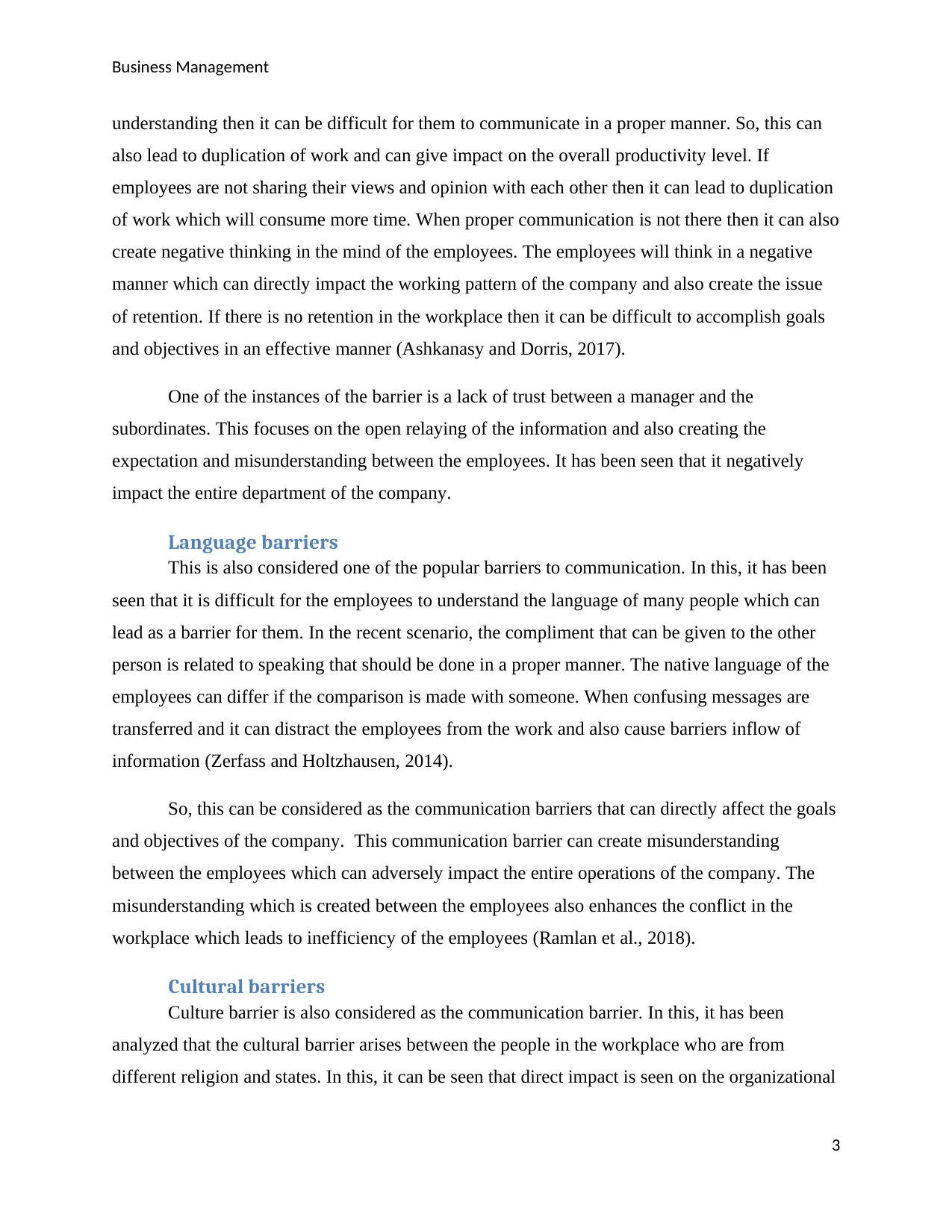
Business Management
understanding then it can be difficult for them to communicate in a proper manner. So, this can
also lead to duplication of work and can give impact on the overall productivity level. If
employees are not sharing their views and opinion with each other then it can lead to duplication
of work which will consume more time. When proper communication is not there then it can also
create negative thinking in the mind of the employees. The employees will think in a negative
manner which can directly impact the working pattern of the company and also create the issue
of retention. If there is no retention in the workplace then it can be difficult to accomplish goals
and objectives in an effective manner (Ashkanasy and Dorris, 2017).
One of the instances of the barrier is a lack of trust between a manager and the
subordinates. This focuses on the open relaying of the information and also creating the
expectation and misunderstanding between the employees. It has been seen that it negatively
impact the entire department of the company.
Language barriers
This is also considered one of the popular barriers to communication. In this, it has been
seen that it is difficult for the employees to understand the language of many people which can
lead as a barrier for them. In the recent scenario, the compliment that can be given to the other
person is related to speaking that should be done in a proper manner. The native language of the
employees can differ if the comparison is made with someone. When confusing messages are
transferred and it can distract the employees from the work and also cause barriers inflow of
information (Zerfass and Holtzhausen, 2014).
So, this can be considered as the communication barriers that can directly affect the goals
and objectives of the company. This communication barrier can create misunderstanding
between the employees which can adversely impact the entire operations of the company. The
misunderstanding which is created between the employees also enhances the conflict in the
workplace which leads to inefficiency of the employees (Ramlan et al., 2018).
Cultural barriers
Culture barrier is also considered as the communication barrier. In this, it has been
analyzed that the cultural barrier arises between the people in the workplace who are from
different religion and states. In this, it can be seen that direct impact is seen on the organizational
3
understanding then it can be difficult for them to communicate in a proper manner. So, this can
also lead to duplication of work and can give impact on the overall productivity level. If
employees are not sharing their views and opinion with each other then it can lead to duplication
of work which will consume more time. When proper communication is not there then it can also
create negative thinking in the mind of the employees. The employees will think in a negative
manner which can directly impact the working pattern of the company and also create the issue
of retention. If there is no retention in the workplace then it can be difficult to accomplish goals
and objectives in an effective manner (Ashkanasy and Dorris, 2017).
One of the instances of the barrier is a lack of trust between a manager and the
subordinates. This focuses on the open relaying of the information and also creating the
expectation and misunderstanding between the employees. It has been seen that it negatively
impact the entire department of the company.
Language barriers
This is also considered one of the popular barriers to communication. In this, it has been
seen that it is difficult for the employees to understand the language of many people which can
lead as a barrier for them. In the recent scenario, the compliment that can be given to the other
person is related to speaking that should be done in a proper manner. The native language of the
employees can differ if the comparison is made with someone. When confusing messages are
transferred and it can distract the employees from the work and also cause barriers inflow of
information (Zerfass and Holtzhausen, 2014).
So, this can be considered as the communication barriers that can directly affect the goals
and objectives of the company. This communication barrier can create misunderstanding
between the employees which can adversely impact the entire operations of the company. The
misunderstanding which is created between the employees also enhances the conflict in the
workplace which leads to inefficiency of the employees (Ramlan et al., 2018).
Cultural barriers
Culture barrier is also considered as the communication barrier. In this, it has been
analyzed that the cultural barrier arises between the people in the workplace who are from
different religion and states. In this, it can be seen that direct impact is seen on the organizational
3
Paraphrase This Document
Need a fresh take? Get an instant paraphrase of this document with our AI Paraphraser
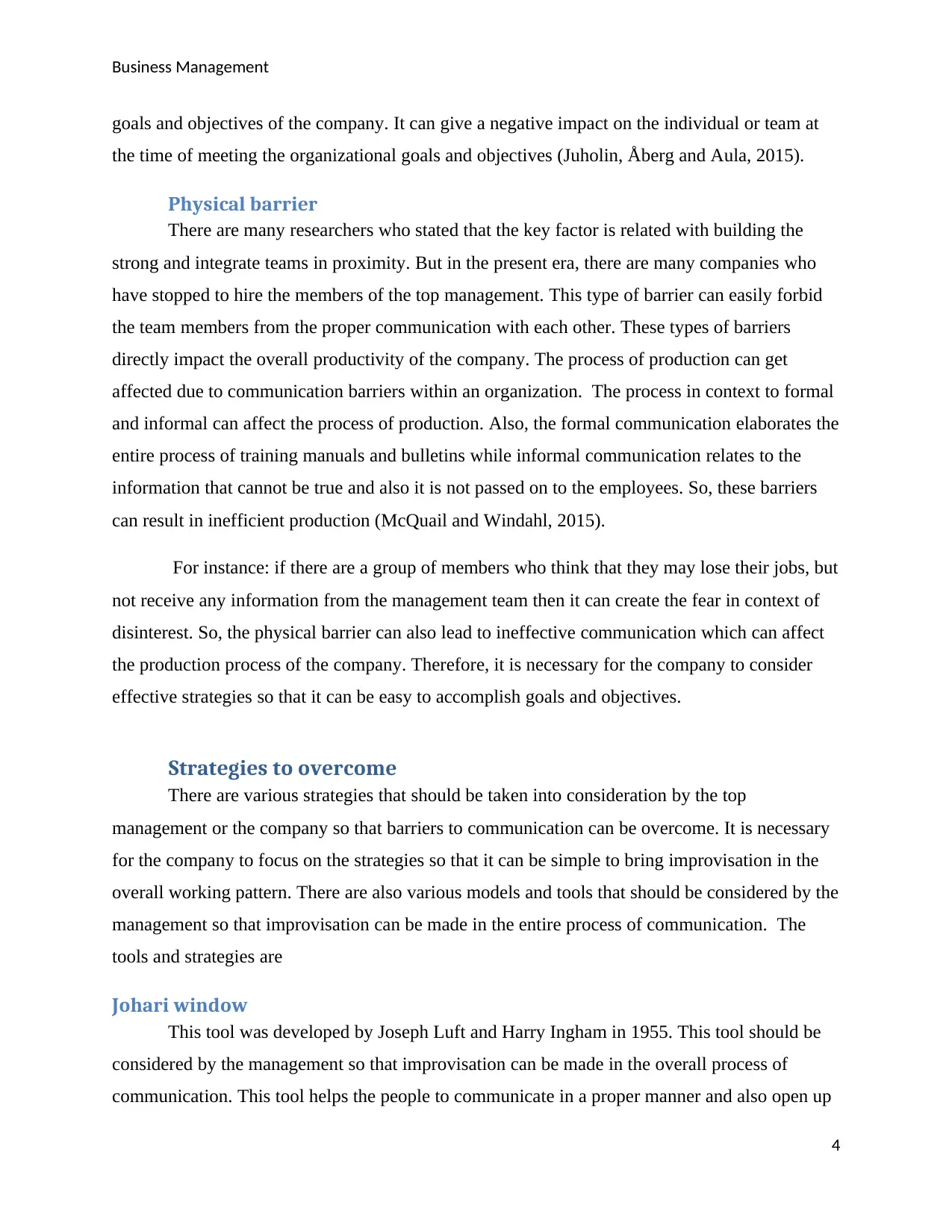
Business Management
goals and objectives of the company. It can give a negative impact on the individual or team at
the time of meeting the organizational goals and objectives (Juholin, Åberg and Aula, 2015).
Physical barrier
There are many researchers who stated that the key factor is related with building the
strong and integrate teams in proximity. But in the present era, there are many companies who
have stopped to hire the members of the top management. This type of barrier can easily forbid
the team members from the proper communication with each other. These types of barriers
directly impact the overall productivity of the company. The process of production can get
affected due to communication barriers within an organization. The process in context to formal
and informal can affect the process of production. Also, the formal communication elaborates the
entire process of training manuals and bulletins while informal communication relates to the
information that cannot be true and also it is not passed on to the employees. So, these barriers
can result in inefficient production (McQuail and Windahl, 2015).
For instance: if there are a group of members who think that they may lose their jobs, but
not receive any information from the management team then it can create the fear in context of
disinterest. So, the physical barrier can also lead to ineffective communication which can affect
the production process of the company. Therefore, it is necessary for the company to consider
effective strategies so that it can be easy to accomplish goals and objectives.
Strategies to overcome
There are various strategies that should be taken into consideration by the top
management or the company so that barriers to communication can be overcome. It is necessary
for the company to focus on the strategies so that it can be simple to bring improvisation in the
overall working pattern. There are also various models and tools that should be considered by the
management so that improvisation can be made in the entire process of communication. The
tools and strategies are
Johari window
This tool was developed by Joseph Luft and Harry Ingham in 1955. This tool should be
considered by the management so that improvisation can be made in the overall process of
communication. This tool helps the people to communicate in a proper manner and also open up
4
goals and objectives of the company. It can give a negative impact on the individual or team at
the time of meeting the organizational goals and objectives (Juholin, Åberg and Aula, 2015).
Physical barrier
There are many researchers who stated that the key factor is related with building the
strong and integrate teams in proximity. But in the present era, there are many companies who
have stopped to hire the members of the top management. This type of barrier can easily forbid
the team members from the proper communication with each other. These types of barriers
directly impact the overall productivity of the company. The process of production can get
affected due to communication barriers within an organization. The process in context to formal
and informal can affect the process of production. Also, the formal communication elaborates the
entire process of training manuals and bulletins while informal communication relates to the
information that cannot be true and also it is not passed on to the employees. So, these barriers
can result in inefficient production (McQuail and Windahl, 2015).
For instance: if there are a group of members who think that they may lose their jobs, but
not receive any information from the management team then it can create the fear in context of
disinterest. So, the physical barrier can also lead to ineffective communication which can affect
the production process of the company. Therefore, it is necessary for the company to consider
effective strategies so that it can be easy to accomplish goals and objectives.
Strategies to overcome
There are various strategies that should be taken into consideration by the top
management or the company so that barriers to communication can be overcome. It is necessary
for the company to focus on the strategies so that it can be simple to bring improvisation in the
overall working pattern. There are also various models and tools that should be considered by the
management so that improvisation can be made in the entire process of communication. The
tools and strategies are
Johari window
This tool was developed by Joseph Luft and Harry Ingham in 1955. This tool should be
considered by the management so that improvisation can be made in the overall process of
communication. This tool helps the people to communicate in a proper manner and also open up
4
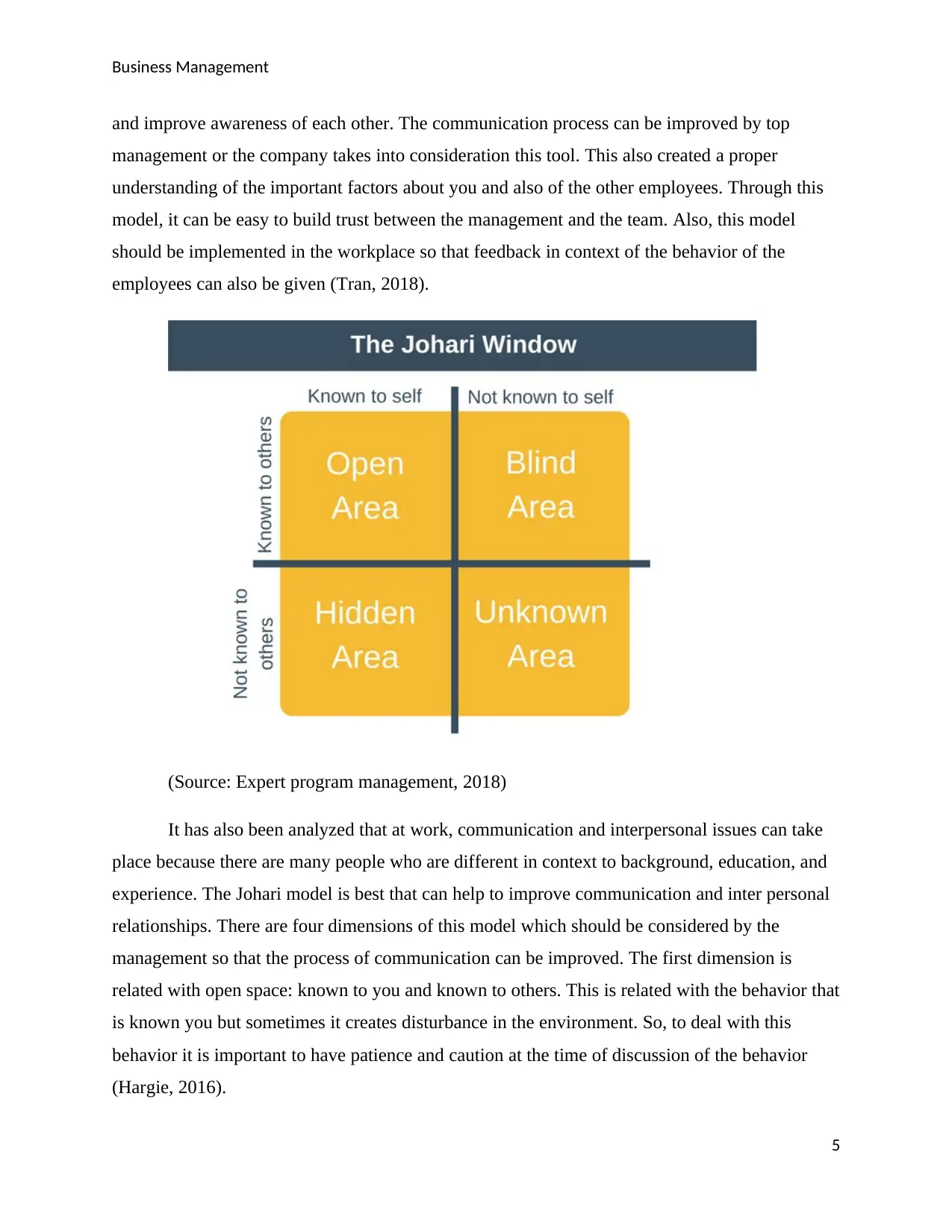
Business Management
and improve awareness of each other. The communication process can be improved by top
management or the company takes into consideration this tool. This also created a proper
understanding of the important factors about you and also of the other employees. Through this
model, it can be easy to build trust between the management and the team. Also, this model
should be implemented in the workplace so that feedback in context of the behavior of the
employees can also be given (Tran, 2018).
(Source: Expert program management, 2018)
It has also been analyzed that at work, communication and interpersonal issues can take
place because there are many people who are different in context to background, education, and
experience. The Johari model is best that can help to improve communication and inter personal
relationships. There are four dimensions of this model which should be considered by the
management so that the process of communication can be improved. The first dimension is
related with open space: known to you and known to others. This is related with the behavior that
is known you but sometimes it creates disturbance in the environment. So, to deal with this
behavior it is important to have patience and caution at the time of discussion of the behavior
(Hargie, 2016).
5
and improve awareness of each other. The communication process can be improved by top
management or the company takes into consideration this tool. This also created a proper
understanding of the important factors about you and also of the other employees. Through this
model, it can be easy to build trust between the management and the team. Also, this model
should be implemented in the workplace so that feedback in context of the behavior of the
employees can also be given (Tran, 2018).
(Source: Expert program management, 2018)
It has also been analyzed that at work, communication and interpersonal issues can take
place because there are many people who are different in context to background, education, and
experience. The Johari model is best that can help to improve communication and inter personal
relationships. There are four dimensions of this model which should be considered by the
management so that the process of communication can be improved. The first dimension is
related with open space: known to you and known to others. This is related with the behavior that
is known you but sometimes it creates disturbance in the environment. So, to deal with this
behavior it is important to have patience and caution at the time of discussion of the behavior
(Hargie, 2016).
5
⊘ This is a preview!⊘
Do you want full access?
Subscribe today to unlock all pages.

Trusted by 1+ million students worldwide
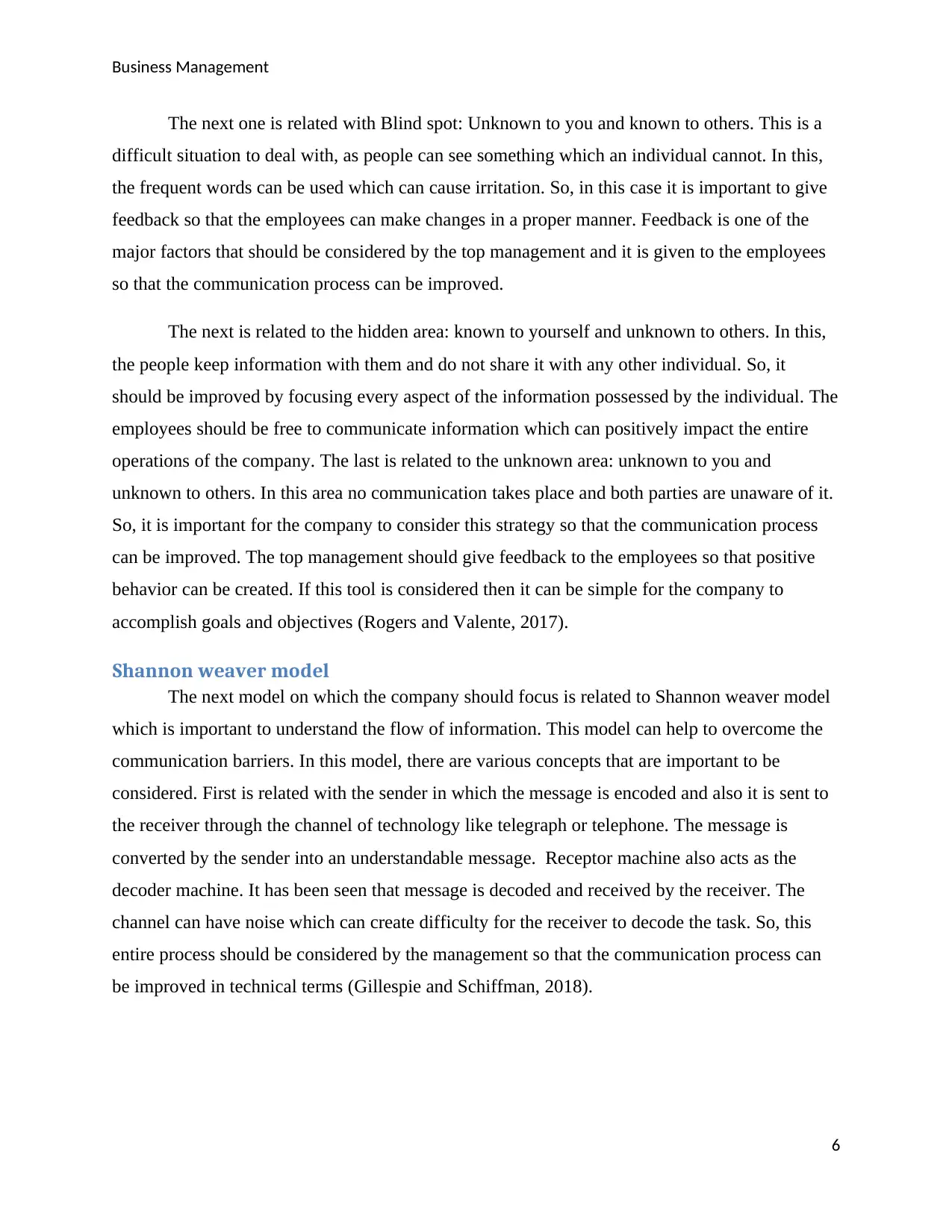
Business Management
The next one is related with Blind spot: Unknown to you and known to others. This is a
difficult situation to deal with, as people can see something which an individual cannot. In this,
the frequent words can be used which can cause irritation. So, in this case it is important to give
feedback so that the employees can make changes in a proper manner. Feedback is one of the
major factors that should be considered by the top management and it is given to the employees
so that the communication process can be improved.
The next is related to the hidden area: known to yourself and unknown to others. In this,
the people keep information with them and do not share it with any other individual. So, it
should be improved by focusing every aspect of the information possessed by the individual. The
employees should be free to communicate information which can positively impact the entire
operations of the company. The last is related to the unknown area: unknown to you and
unknown to others. In this area no communication takes place and both parties are unaware of it.
So, it is important for the company to consider this strategy so that the communication process
can be improved. The top management should give feedback to the employees so that positive
behavior can be created. If this tool is considered then it can be simple for the company to
accomplish goals and objectives (Rogers and Valente, 2017).
Shannon weaver model
The next model on which the company should focus is related to Shannon weaver model
which is important to understand the flow of information. This model can help to overcome the
communication barriers. In this model, there are various concepts that are important to be
considered. First is related with the sender in which the message is encoded and also it is sent to
the receiver through the channel of technology like telegraph or telephone. The message is
converted by the sender into an understandable message. Receptor machine also acts as the
decoder machine. It has been seen that message is decoded and received by the receiver. The
channel can have noise which can create difficulty for the receiver to decode the task. So, this
entire process should be considered by the management so that the communication process can
be improved in technical terms (Gillespie and Schiffman, 2018).
6
The next one is related with Blind spot: Unknown to you and known to others. This is a
difficult situation to deal with, as people can see something which an individual cannot. In this,
the frequent words can be used which can cause irritation. So, in this case it is important to give
feedback so that the employees can make changes in a proper manner. Feedback is one of the
major factors that should be considered by the top management and it is given to the employees
so that the communication process can be improved.
The next is related to the hidden area: known to yourself and unknown to others. In this,
the people keep information with them and do not share it with any other individual. So, it
should be improved by focusing every aspect of the information possessed by the individual. The
employees should be free to communicate information which can positively impact the entire
operations of the company. The last is related to the unknown area: unknown to you and
unknown to others. In this area no communication takes place and both parties are unaware of it.
So, it is important for the company to consider this strategy so that the communication process
can be improved. The top management should give feedback to the employees so that positive
behavior can be created. If this tool is considered then it can be simple for the company to
accomplish goals and objectives (Rogers and Valente, 2017).
Shannon weaver model
The next model on which the company should focus is related to Shannon weaver model
which is important to understand the flow of information. This model can help to overcome the
communication barriers. In this model, there are various concepts that are important to be
considered. First is related with the sender in which the message is encoded and also it is sent to
the receiver through the channel of technology like telegraph or telephone. The message is
converted by the sender into an understandable message. Receptor machine also acts as the
decoder machine. It has been seen that message is decoded and received by the receiver. The
channel can have noise which can create difficulty for the receiver to decode the task. So, this
entire process should be considered by the management so that the communication process can
be improved in technical terms (Gillespie and Schiffman, 2018).
6
Paraphrase This Document
Need a fresh take? Get an instant paraphrase of this document with our AI Paraphraser
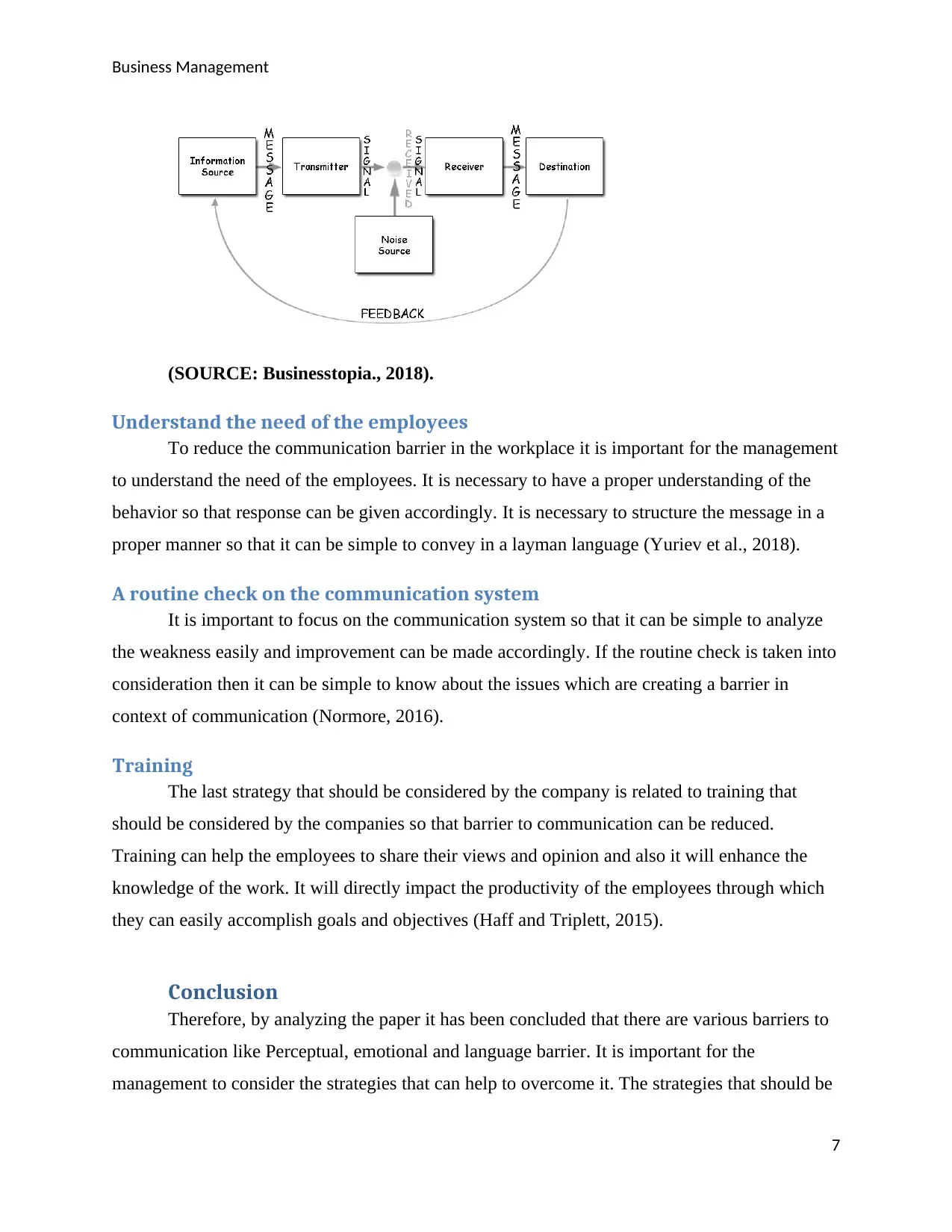
Business Management
(SOURCE: Businesstopia., 2018).
Understand the need of the employees
To reduce the communication barrier in the workplace it is important for the management
to understand the need of the employees. It is necessary to have a proper understanding of the
behavior so that response can be given accordingly. It is necessary to structure the message in a
proper manner so that it can be simple to convey in a layman language (Yuriev et al., 2018).
A routine check on the communication system
It is important to focus on the communication system so that it can be simple to analyze
the weakness easily and improvement can be made accordingly. If the routine check is taken into
consideration then it can be simple to know about the issues which are creating a barrier in
context of communication (Normore, 2016).
Training
The last strategy that should be considered by the company is related to training that
should be considered by the companies so that barrier to communication can be reduced.
Training can help the employees to share their views and opinion and also it will enhance the
knowledge of the work. It will directly impact the productivity of the employees through which
they can easily accomplish goals and objectives (Haff and Triplett, 2015).
Conclusion
Therefore, by analyzing the paper it has been concluded that there are various barriers to
communication like Perceptual, emotional and language barrier. It is important for the
management to consider the strategies that can help to overcome it. The strategies that should be
7
(SOURCE: Businesstopia., 2018).
Understand the need of the employees
To reduce the communication barrier in the workplace it is important for the management
to understand the need of the employees. It is necessary to have a proper understanding of the
behavior so that response can be given accordingly. It is necessary to structure the message in a
proper manner so that it can be simple to convey in a layman language (Yuriev et al., 2018).
A routine check on the communication system
It is important to focus on the communication system so that it can be simple to analyze
the weakness easily and improvement can be made accordingly. If the routine check is taken into
consideration then it can be simple to know about the issues which are creating a barrier in
context of communication (Normore, 2016).
Training
The last strategy that should be considered by the company is related to training that
should be considered by the companies so that barrier to communication can be reduced.
Training can help the employees to share their views and opinion and also it will enhance the
knowledge of the work. It will directly impact the productivity of the employees through which
they can easily accomplish goals and objectives (Haff and Triplett, 2015).
Conclusion
Therefore, by analyzing the paper it has been concluded that there are various barriers to
communication like Perceptual, emotional and language barrier. It is important for the
management to consider the strategies that can help to overcome it. The strategies that should be
7
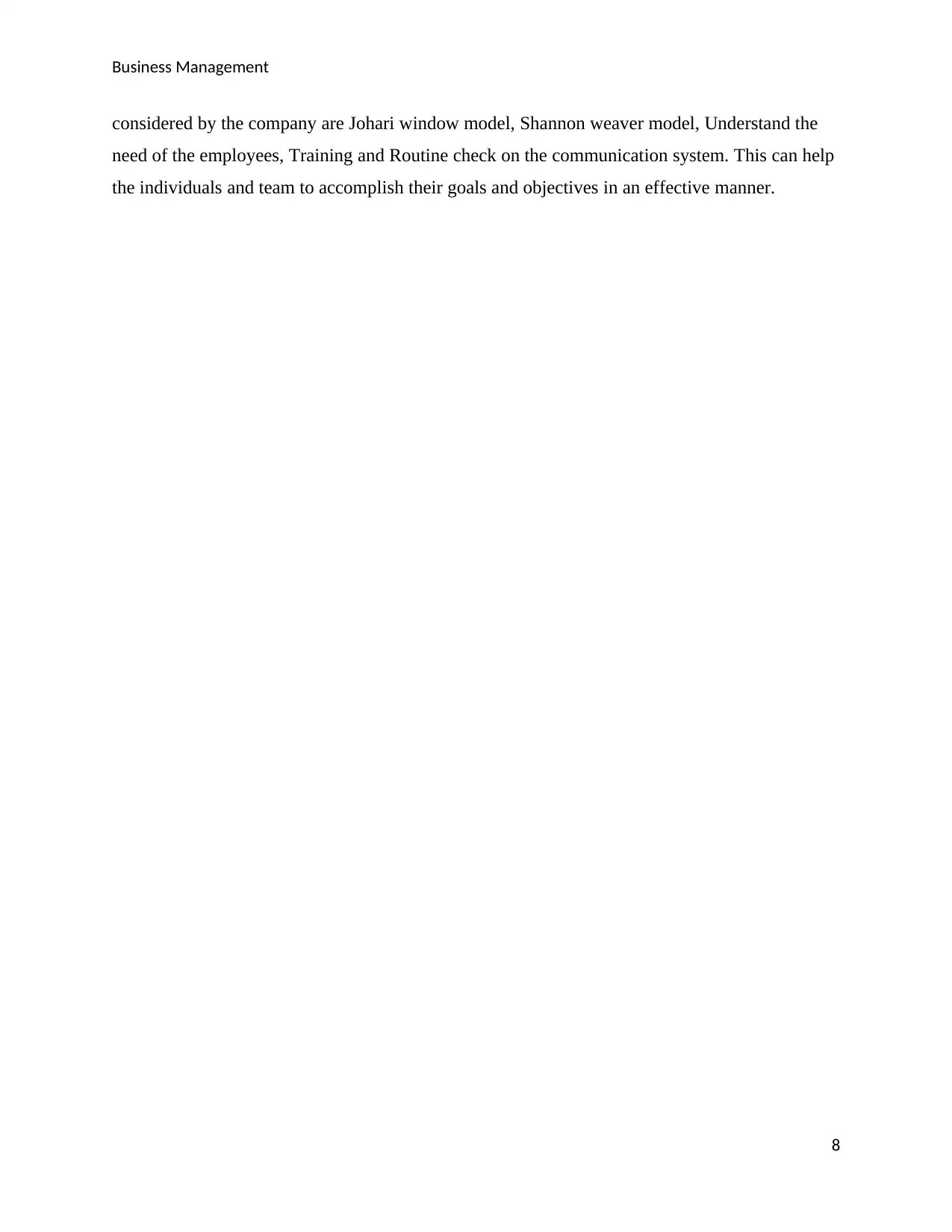
Business Management
considered by the company are Johari window model, Shannon weaver model, Understand the
need of the employees, Training and Routine check on the communication system. This can help
the individuals and team to accomplish their goals and objectives in an effective manner.
8
considered by the company are Johari window model, Shannon weaver model, Understand the
need of the employees, Training and Routine check on the communication system. This can help
the individuals and team to accomplish their goals and objectives in an effective manner.
8
⊘ This is a preview!⊘
Do you want full access?
Subscribe today to unlock all pages.

Trusted by 1+ million students worldwide
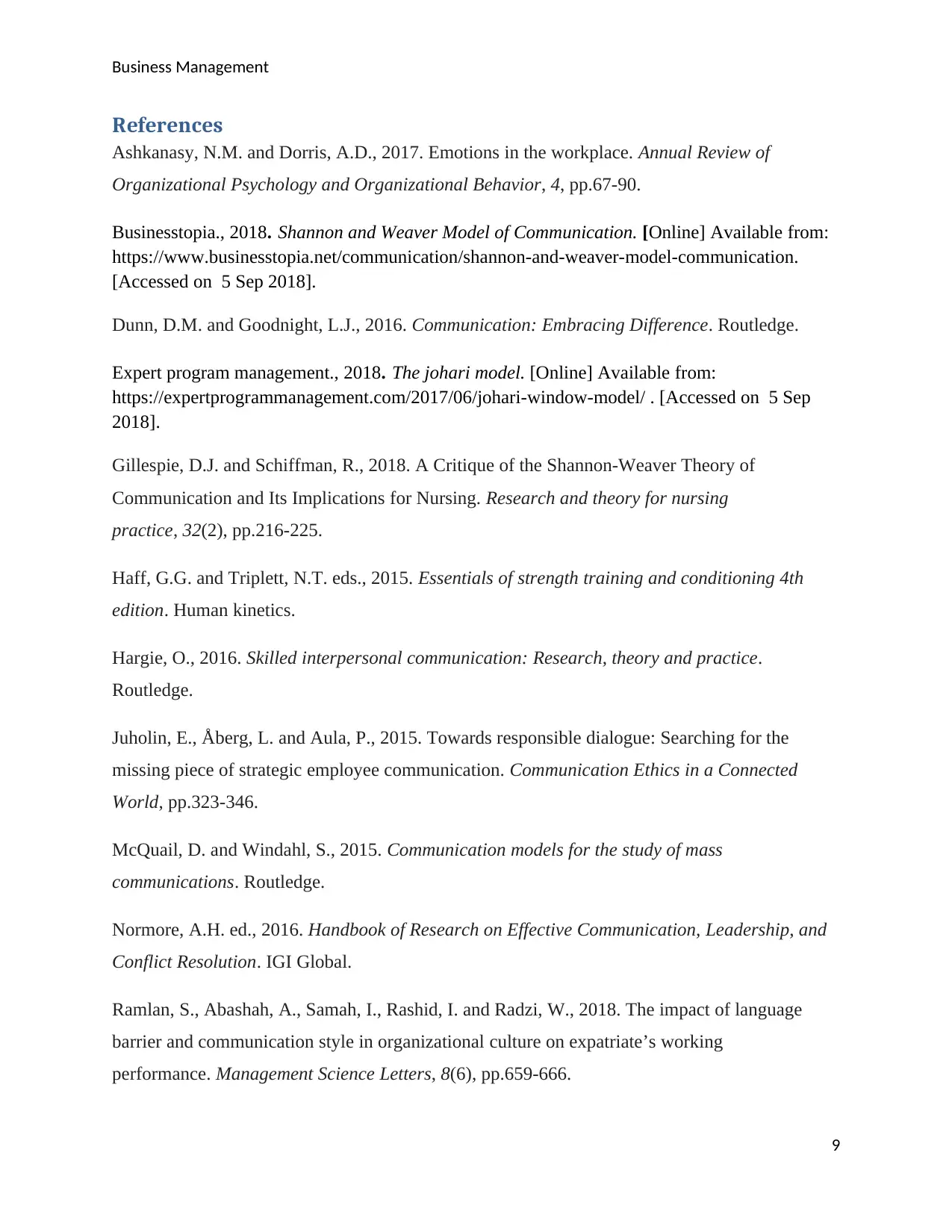
Business Management
References
Ashkanasy, N.M. and Dorris, A.D., 2017. Emotions in the workplace. Annual Review of
Organizational Psychology and Organizational Behavior, 4, pp.67-90.
Businesstopia., 2018. Shannon and Weaver Model of Communication. [Online] Available from:
https://www.businesstopia.net/communication/shannon-and-weaver-model-communication.
[Accessed on 5 Sep 2018].
Dunn, D.M. and Goodnight, L.J., 2016. Communication: Embracing Difference. Routledge.
Expert program management., 2018. The johari model. [Online] Available from:
https://expertprogrammanagement.com/2017/06/johari-window-model/ . [Accessed on 5 Sep
2018].
Gillespie, D.J. and Schiffman, R., 2018. A Critique of the Shannon-Weaver Theory of
Communication and Its Implications for Nursing. Research and theory for nursing
practice, 32(2), pp.216-225.
Haff, G.G. and Triplett, N.T. eds., 2015. Essentials of strength training and conditioning 4th
edition. Human kinetics.
Hargie, O., 2016. Skilled interpersonal communication: Research, theory and practice.
Routledge.
Juholin, E., Åberg, L. and Aula, P., 2015. Towards responsible dialogue: Searching for the
missing piece of strategic employee communication. Communication Ethics in a Connected
World, pp.323-346.
McQuail, D. and Windahl, S., 2015. Communication models for the study of mass
communications. Routledge.
Normore, A.H. ed., 2016. Handbook of Research on Effective Communication, Leadership, and
Conflict Resolution. IGI Global.
Ramlan, S., Abashah, A., Samah, I., Rashid, I. and Radzi, W., 2018. The impact of language
barrier and communication style in organizational culture on expatriate’s working
performance. Management Science Letters, 8(6), pp.659-666.
9
References
Ashkanasy, N.M. and Dorris, A.D., 2017. Emotions in the workplace. Annual Review of
Organizational Psychology and Organizational Behavior, 4, pp.67-90.
Businesstopia., 2018. Shannon and Weaver Model of Communication. [Online] Available from:
https://www.businesstopia.net/communication/shannon-and-weaver-model-communication.
[Accessed on 5 Sep 2018].
Dunn, D.M. and Goodnight, L.J., 2016. Communication: Embracing Difference. Routledge.
Expert program management., 2018. The johari model. [Online] Available from:
https://expertprogrammanagement.com/2017/06/johari-window-model/ . [Accessed on 5 Sep
2018].
Gillespie, D.J. and Schiffman, R., 2018. A Critique of the Shannon-Weaver Theory of
Communication and Its Implications for Nursing. Research and theory for nursing
practice, 32(2), pp.216-225.
Haff, G.G. and Triplett, N.T. eds., 2015. Essentials of strength training and conditioning 4th
edition. Human kinetics.
Hargie, O., 2016. Skilled interpersonal communication: Research, theory and practice.
Routledge.
Juholin, E., Åberg, L. and Aula, P., 2015. Towards responsible dialogue: Searching for the
missing piece of strategic employee communication. Communication Ethics in a Connected
World, pp.323-346.
McQuail, D. and Windahl, S., 2015. Communication models for the study of mass
communications. Routledge.
Normore, A.H. ed., 2016. Handbook of Research on Effective Communication, Leadership, and
Conflict Resolution. IGI Global.
Ramlan, S., Abashah, A., Samah, I., Rashid, I. and Radzi, W., 2018. The impact of language
barrier and communication style in organizational culture on expatriate’s working
performance. Management Science Letters, 8(6), pp.659-666.
9
Paraphrase This Document
Need a fresh take? Get an instant paraphrase of this document with our AI Paraphraser
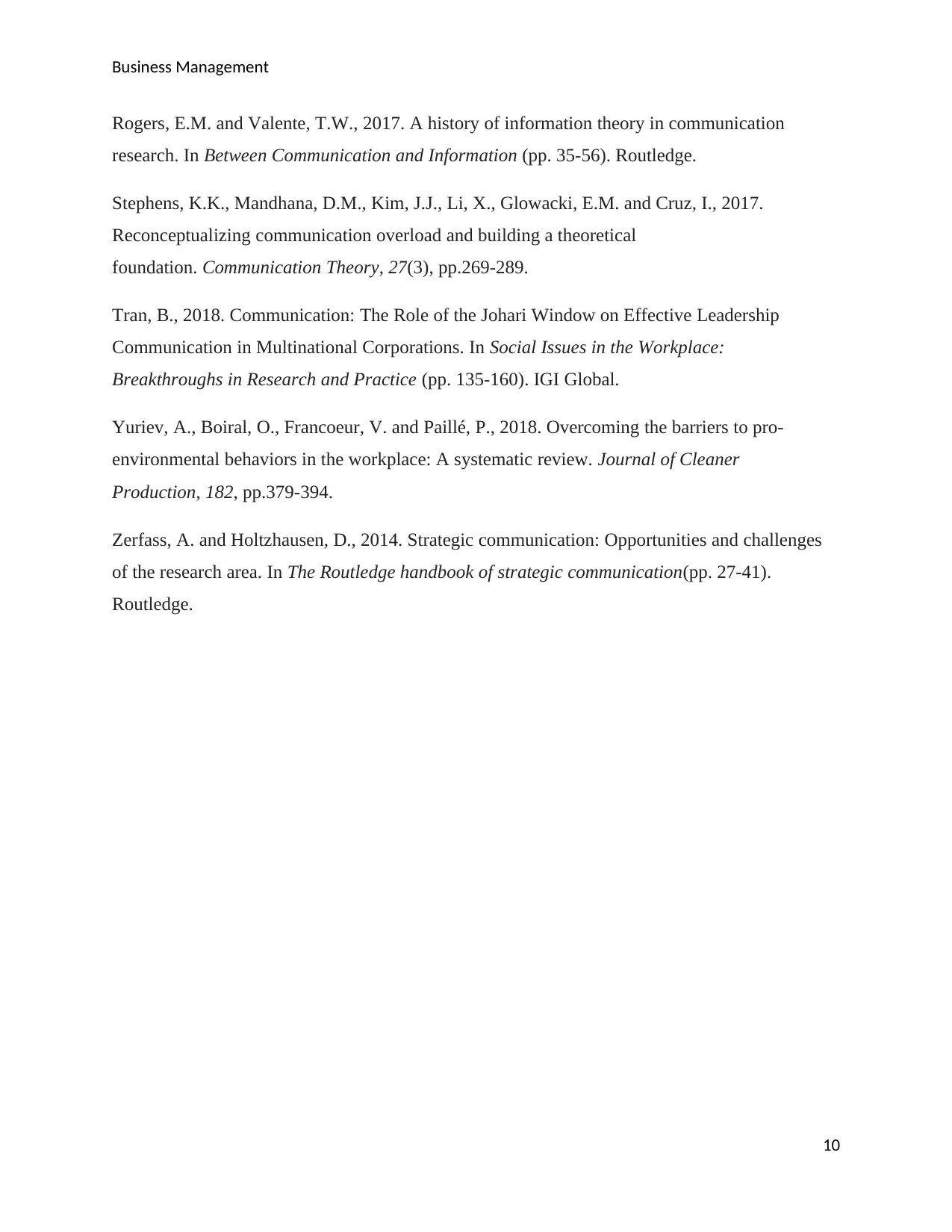
Business Management
Rogers, E.M. and Valente, T.W., 2017. A history of information theory in communication
research. In Between Communication and Information (pp. 35-56). Routledge.
Stephens, K.K., Mandhana, D.M., Kim, J.J., Li, X., Glowacki, E.M. and Cruz, I., 2017.
Reconceptualizing communication overload and building a theoretical
foundation. Communication Theory, 27(3), pp.269-289.
Tran, B., 2018. Communication: The Role of the Johari Window on Effective Leadership
Communication in Multinational Corporations. In Social Issues in the Workplace:
Breakthroughs in Research and Practice (pp. 135-160). IGI Global.
Yuriev, A., Boiral, O., Francoeur, V. and Paillé, P., 2018. Overcoming the barriers to pro-
environmental behaviors in the workplace: A systematic review. Journal of Cleaner
Production, 182, pp.379-394.
Zerfass, A. and Holtzhausen, D., 2014. Strategic communication: Opportunities and challenges
of the research area. In The Routledge handbook of strategic communication(pp. 27-41).
Routledge.
10
Rogers, E.M. and Valente, T.W., 2017. A history of information theory in communication
research. In Between Communication and Information (pp. 35-56). Routledge.
Stephens, K.K., Mandhana, D.M., Kim, J.J., Li, X., Glowacki, E.M. and Cruz, I., 2017.
Reconceptualizing communication overload and building a theoretical
foundation. Communication Theory, 27(3), pp.269-289.
Tran, B., 2018. Communication: The Role of the Johari Window on Effective Leadership
Communication in Multinational Corporations. In Social Issues in the Workplace:
Breakthroughs in Research and Practice (pp. 135-160). IGI Global.
Yuriev, A., Boiral, O., Francoeur, V. and Paillé, P., 2018. Overcoming the barriers to pro-
environmental behaviors in the workplace: A systematic review. Journal of Cleaner
Production, 182, pp.379-394.
Zerfass, A. and Holtzhausen, D., 2014. Strategic communication: Opportunities and challenges
of the research area. In The Routledge handbook of strategic communication(pp. 27-41).
Routledge.
10
1 out of 11
Related Documents
Your All-in-One AI-Powered Toolkit for Academic Success.
+13062052269
info@desklib.com
Available 24*7 on WhatsApp / Email
![[object Object]](/_next/static/media/star-bottom.7253800d.svg)
Unlock your academic potential
Copyright © 2020–2025 A2Z Services. All Rights Reserved. Developed and managed by ZUCOL.




